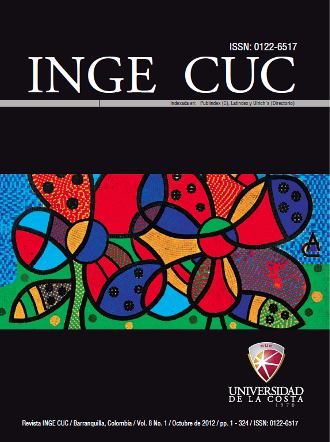Las redes de sensores inalámbricos y el internet de las cosas
Keywords:
Internet de las cosas, IoT, 6LoWPAN, RPL, redes de sensores inalámbricos, WSN, IEEE 802.15.4.Abstract
El Internet de las cosas (IoT) percibe un mundo donde los dispositivos que lo conforman pueden ser identificados en el Internet y está creciendo a un ritmo acelerado con nuevos dispositivos que se van conectando. En este sentido, las redes de sensores inalámbricos juegan un papel importante para incrementar la ubicuidad de las redes con dispositivos inteligentes de bajo costo y fácil implementación, con estándares como IEEE 802.15.4 en la capa física, 6LoWPAN en la capa de red, y RPL como protocolo de enrutamiento, que se integran en el concepto de IoT para traer nuevas experiencias en las actividades de la vida diaria, como por ejemplo en aplicaciones para hogares y oficinas confortables, salud, vigilancia del medio ambiente y ciudades inteligentes. En el presente artículo se relacionará a la red de sensores inalámbricos con el Internet de las cosas a través de estándares y protocolos.
Downloads
References
[2] S. Tarkoma and H. Ailisto, “The Internet of Things Program: The finnish perspective”. IEEE Communications Magazine, 51(3):10-11, 2013.
[3] Z. Shelby and C. Bormann, 6LoWPAN: the wireless embedded internet, Wiley, pp. 1-25, 2011.
[4] G. Kortuem, F. Kawsar, D. Fitton and V. Sundramoorthy, “Smart objects as building blocks for the Internet of things”. Internet Computing, IEEE, vol. 14(1), pp. 44 - 51, 2010.
[5] Qian Zhu et al., “IOT Gateway: bridging wireless sensor networks into internet of things”. IEEE/IFIP 8th International Conference on Embedded and Ubiquitous Computing (EUC), pp. 347-352, Hong Kong, China, 2010.
[6] G. Montenegro, N. Kushalnagar, J. Hui, D. Culler, Transmission of IPv6 packets over IEEE 802.15.4 networks, RFC 4944, 2007.
[7] J. Hui and P. Thubert, Compression format for IPv6 datagrams over IEEE 802.15.4-based networks, RFC6282, 2011.
[8] N. Kushalnagar, G. Montenegro and C. Schumacher, IPv6 over low-power wireless personal area networks (6LoWPANs): overview, assumptions, problem statement, and goals, RFC4919, 2007.
[9] A. Koubaa, S. Chaudhry, M. Tezeghdanti, R. Chaari and M. Abid, “Simulation and performance evaluation of DAG construction with RPL”. Third international conference on communications and networking (ComNet), pp. 1-8, 2012.
[10] W. Rukpakavong, I. Phillips, L. Guan and G. Oikonom, “RPL Router Discovery for Supporting Energy-Efficient Transmission in Single-hop 6LoWPAN”. IEEE International Conference on Communications. Article number 6364812, pp. 5721-5725, 2012.
[11] G. Mulligan, “6LoWPAN Working Group: The 6LoWPAN Architecture”. The Fourth Workshop on Embedded Networked Sensors, EmNets, 2007.
[12] J. Hui and P. Thubert, RFC 6282, Compression format for IPv6 datagrams over IEEE 802.15.4-Based Networks. ISSN:2070-1721, 2011.
[13] A. Ludovici, A. Calveras and J. Casademont, “Forwarding Techniques for IP Fragmented Packets in a Real 6LoWPAN Network”. Sensors, vol. 11(1), 992-1008; doi:10.3390/s110100992, 2011.
[14] M. Felsche, A. Huhn and H. Schwetlick, “Routing Protocols for 6LoWPAN”. Lecture Notes of the Institute for Computer Sciences, Social Informatics and Telecommunications Engineering, 82: 71-83, 2012.
[15] H. R. Kermajani and C. Gomez, “Route change latency in low-power and lossy wireless networks using RPL and 6LoWPAN Neighbor Discovery”. IEEE Symposium on Computers and Communications (ISCC), pp. 937 - 942, 2011.
[16] Jeonggil Ko, A. Terzis, S. Dawson-Haggerty, D. E. Culler, J. W. Hui and P. Levis, “Connecting low-power and lossy networks to the Internet”. Communications Magazine, IEEE, vol. 49(4), pp. 96-101, 2011.
[17] Jeonggil Ko, O. Gnawali, D. Culler and A. Terzis, “Evaluating the Performance of RPL and 6LoWPAN in TinyOS”. In: Proceedings of the workshop on extending the internet to low power and lossy networks, IPSN, 2011.
[18] Nguyen Thanh Long, N. De Caro, W. Colitti, A. Touhafi and K. Steenhaut, “Comparative Performance Study of RPL in Wireless Sensor Networks”. IEEE 19th Symposium on Communications and Vehicular Technology in the Benelux (SCVT), pp. 1-6, 2012.
[19] A. Calveras and A. Ludovici, “Implementation and evaluation of Multi-hop routing in 6LoWPAN”. IX Jornadas de Ingeniería Telemática, JITEL, Universidad de Valladolid, 2010, pp. 1-6.
[20] P. Rajasekaran, R. P. Janardhan and R. P. V. Chander, “A Smarter Toll Gate Based on Web Of Things”. IEEE International conference on electronics, computing and communication technologies (CONECCT), pp.1-6, 2013.
[21] Z. Shelby, “Embedded web services”. Wireless Communications, IEEE, vol. 17(6), pp. 52-57, 2010.
[22] C. Bormann, A. P. Castellani and Z. Shelby, “CoAP: An Application Protocol for Billions of Tiny Internet Nodes”. Internet Computing, IEEE, vol. 16(2), pp. 62-67, 2012.
[23] K. Machado, D. Rosário, E. Cerqueira, A. A. F. Loureiro, A. Neto and J. Neuman de Souza, “A Routing Protocol Based on Energy and Link Quality for Internet of Things Applications”. Sensors, 13 (2): 1942- 1964, doi: 10.3390/s130201942, 2013.
[24] Seventh Framework Programme (FP7), [Online]. Disponible en: http://ec.europa.eu/research/participants/portal/page/fp7_documentation
Downloads
Published
How to Cite
Issue
Section
License
Published papers are the exclusive responsibility of their authors and do not necessary reflect the opinions of the editorial committee.
INGE CUC Journal respects the moral rights of its authors, whom must cede the editorial committee the patrimonial rights of the published material. In turn, the authors inform that the current work is unpublished and has not been previously published.
All articles are licensed under a Creative Commons Attribution-NonCommercial-NoDerivatives 4.0 International License.



 English
English
 Español (España)
Español (España)






















